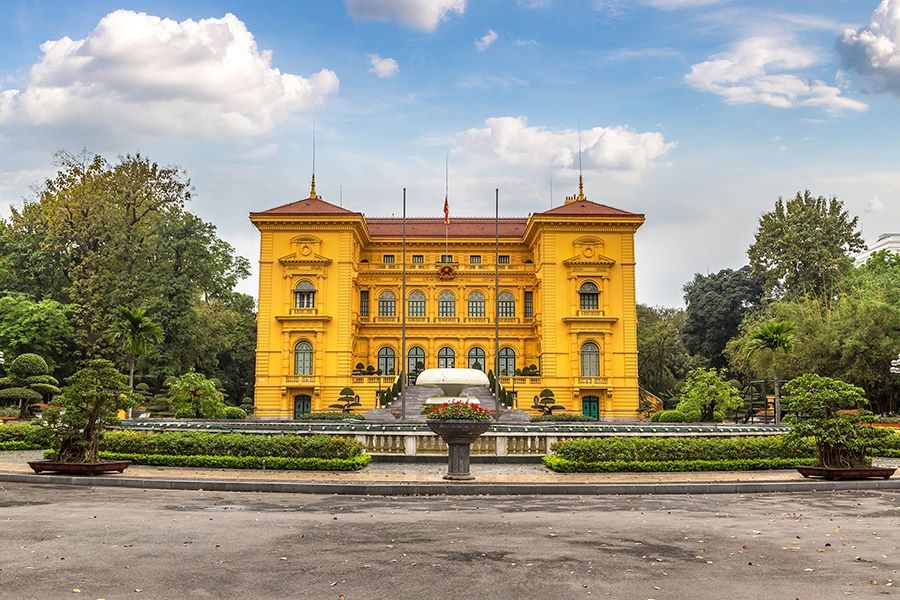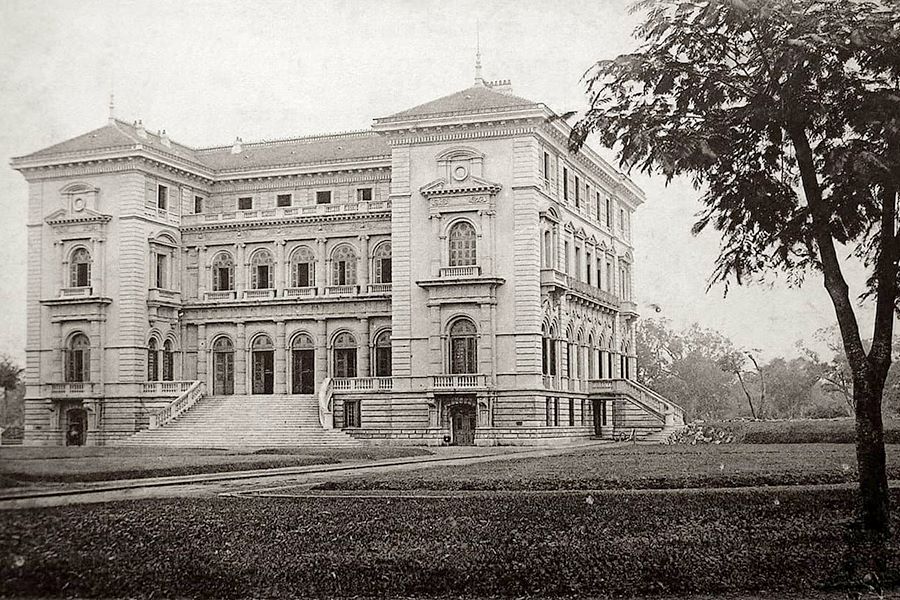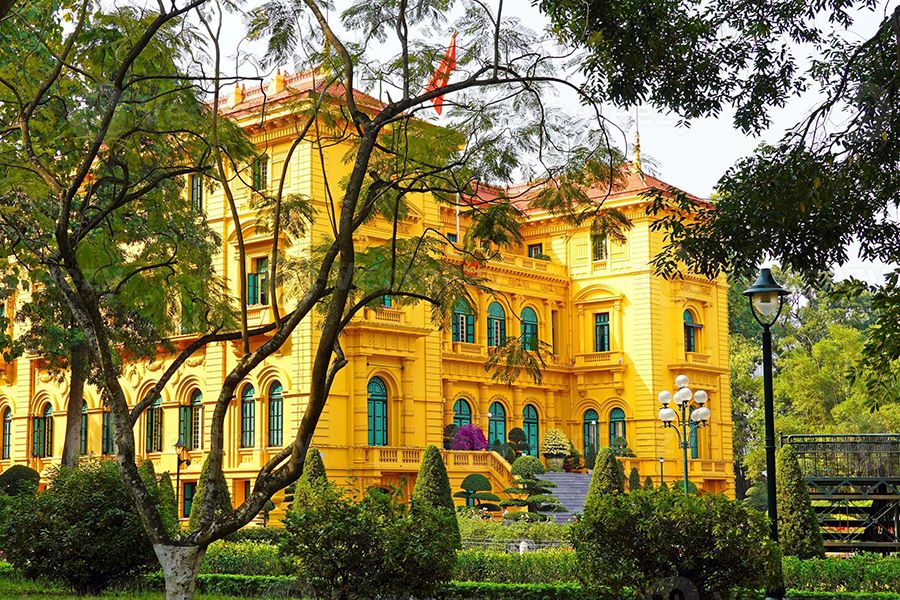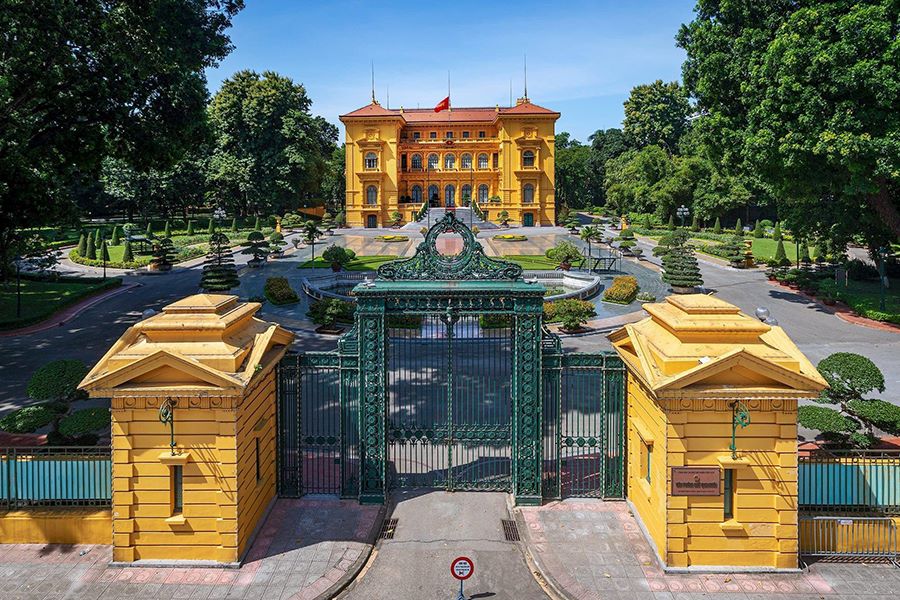Every visitor coming to Hanoi then does not miss the opportunity to visit Presidential Palace – where President Ho Chi Minh lived and worked during the years after reunification. It brings great historical value as well as the importance for the country. This area has become a sightseeing associated with Ho Chi Minh Mausoleum on Indochina tours.
History of the Presidential Palace in Hanoi
The historical site of the Presidential Palace is situated in Ngoc Ha Ward, Ba Dinh District, Ha Noi, near Ho Chi Minh Mausoleum, One Pillar Pagoda, and Ho Chi Minh Museum. Presidential Palace was formerly the Governor of Indochina built between 1900 and 1906, designed by a French architect according to Roman style, a kind of Western architecture. Within 15 years, President Ho Chi Minh welcomed over 1000 delegates both domestic and international here. He also read poems for Tet (Lunar New Year) here.
The Architecture of the Hanoi Presidential Palace
Being one of the largest palaces built by the French in Indochina at the time of war, the palace covers 30 rooms, especially each room has a different décor. The structure is covered with dark yellow lime and lies behind a large iron gate.
The building is designed symmetrically. Specifically, it has two main floors, located on a podium, the top is an attic. The second floor was used as a living room, work room, and banquet room. The rooms here are large, designed formally, and suitable for meetings. The third floor was designed to have private rooms for accommodation and resting places.
The architecture of the palace is a flawless combination between France and Italy. Only the surrounding area where Vietnamese plants such as mangos, and logans…were put in, brings Vietnam style to it. It used to be the workplace of President Ho Chi Minh and the important activities of the country were also carried out here. However, after Ho Chi Minh's death, it became one of the historic sites about him.
Presidential Palace in Hanoi: Entrance fee, Opening Hours
President Ho Chi Minh lived and worked at the Presidential Palace, which is a part of the Presidential Palace Historical Site complex, from December 19, 1954 to September 2, 1969. The structure, which is regarded as a unique national relic site, is compared to a museum showcasing President Ho's life. The residents of Ho Chi Minh and the surrounding areas are still accessible to tourists, even though the Presidential Palace is closed to them.
Location: No. 2, Hung Vuong Street, Ngoc Ha Ward, Ba Dinh District, Hanoi, Vietnam
Opening hours: every day except Monday afternoons and Friday afternoons
- Summer (April - October): 7:30 - 11 am and 1:30 - 4 pm
- Winter (November - March): 8 - 11 am and 1:30 - 4 pm
Entrance fee:
- Free for Vietnamese visitors
- 40,000 VND/ticket for foreign visitors
The Presidential Palace is conveniently located in the center of Hanoi, just a short 15-minute drive from the Old Quarter. It is easily accessible by taxi, motorcycle, or foot. You can also ride the 09, 22, 45, and 50 public buses that pass by the area.
Attractions Nearby Hanoi Presidential Palace
Wooden Stilt House
President Ho resided and worked in the wooden stilt house from 1958 until 1969. It was constructed of Menghundor, a popular wood in Vietnam, and had a roof covered with baked clay tiles. The President's living room on the first level served as a gathering place for visitors. He worked and slept on the second level, which had two rooms measuring ten square meters each. The President lived a modest lifestyle, which was reflected in the house's simple yet tidy furnishings.
Uncle Ho’s Fish Bond
President Ho decided to convert the surrounding naturally occurring muddy pond into a fish pond when he moved into the house on stilts in 1958. The pond is two meters deep and more than 3,000 square meters in size. Here, a variety of fish were raised, including carp and ruffe. In the pond, mussels that lived there also produced pearls. Every afternoon after work, the President would feed them.





